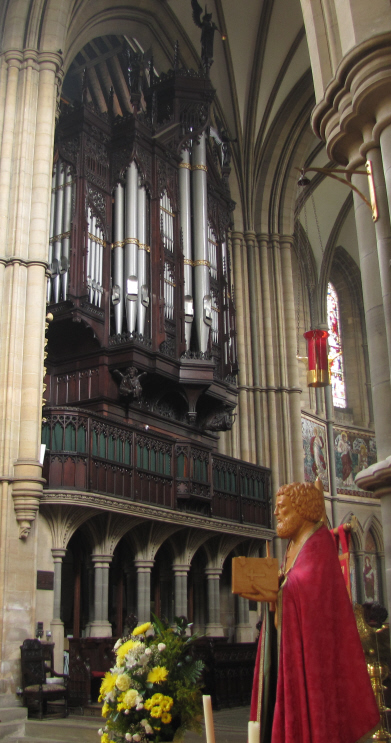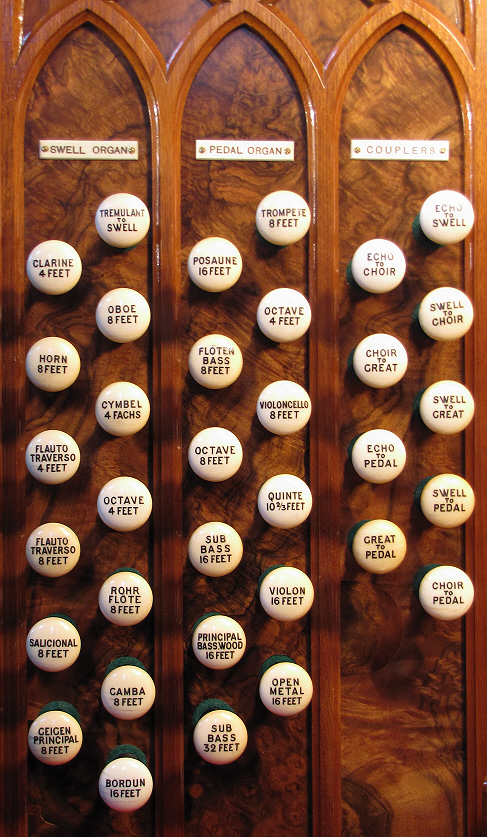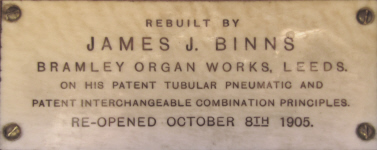

Hauptwerk (v5 and upwards) Virtual Organ
© Lavender Audio 2008 -

As has been discussed, the organs of Schulze were highly influential to the organ builders of England in the latter half of the 19th century. In true German romantic tradition, this instrument sets the flue chorus at its heart, but – unlike quite a few of its continental contemporaries – a reasonable variety of chorus reeds are provided. Indeed, for a builder who was noted for his innovations and developments in flue pipework, the reeds at Armley are of a uniformly excellent quality and expand the range of suitable repertoire significantly. For example, whilst it would be expected that the German late classical and romantic music of the likes of Mendelssohn, Rheinberger, Liszt and even Reger would sound good on this instrument, much of the French romantic period works well too. Although the Schulze sound is quite some way from that of a Cavaille-
The four manual divisions have what can be described as “terraced dynamics”, with the Great containing the loudest stops, whilst the Swell, Choir and Echo have progressively quieter sounds. The Pedal underpins each division very effectively and even the quietest stops of the Echo are generally not overpowered by the Pedal 16' Sub Bass. If a quieter 16' tone is desired, there are coupling options on all manuals. During the latest rebuild, the Choir and Echo divisions were moved to the same level as the Great, thus allowing the more delicate sounds contained here to be heard more effectively. The Swell is situated above the Great and speaks out clearly into the Chancel – the highly efficient enclosure allows for considerable dynamic changes to be employed. Despite its romantic leanings, each manual has a proper chorus based on a 16' pitch – the Great Mixtur, Swell Cymbel and Choir Cornett all have harmonics from the 16' series sounding in the treble of their compass and so require an appropriate 16' manual stop to be drawn for these stops to sound as intended.
THE ORGAN IN USE TODAY

Despite this, the Schulze Principal chorus work is noted for its brilliance and power … nowhere is this more evident than the famous Great Mixtur V, which has been described as being like “canned lightning”. Indeed, so impressed was Arthur Harrison when he first visited Armley in the early twentieth century, he noted the composition of this stop accurately for future reference.
Possibly the finest stops at Armley though are the flutes – on every division there are flute families at 16', 8' and 4' pitch and there is a real contrast between the different families. Anyone lamenting the lack of an 8' + 2' combination is reminded that with a manual compass of 61 notes, playing 16' + 4' up the octave is often a viable alternative. The families of strings are no less impressive, with excellent options on the Swell for French music (especially the keen sounding Gamba) to the rather quirky Cello und Violone on the Choir, whose chiffy starting transient is meant to sound like the attack of bow on string. Possibly the most flexible stop on the Swell is the Celeste (still bearing its original Rohr Flöte stop knob as mentioned previously). Whilst it's probably at its best when combined with the Salicional, when added to the Gamba a French sounding Voix Celeste is the result, whereas Celeste and Flauto Traverso 8' gives a very pleasant Unda Maris effect.
Although individual registers can and do sound very impressive, Schulze's strength as a voicer was his ability to allow different stops to blend with one another, producing a great variety of new sounds. As alluded to above, trying combinations of stops at different pitches can be very rewarding. The chorus reeds can also give good service as solo reeds with the Great Trompete being a very good example of this. When carrying out his restoration work in 1905, J.J. Binns was largely conservative in that he respected the voicing traditions of Schulze and made no tonal alterations, save for a raising of the overall pitch (this was partially reversed during the work in 2004). However, his installation of tremulants to Swell, Choir and Echo have further enhanced the romantic credentials of the organ. Of course, use of these is entirely optional and whilst the typical Binns style may be a little fast for some tastes, there's no doubting the additional possibilities they present.






